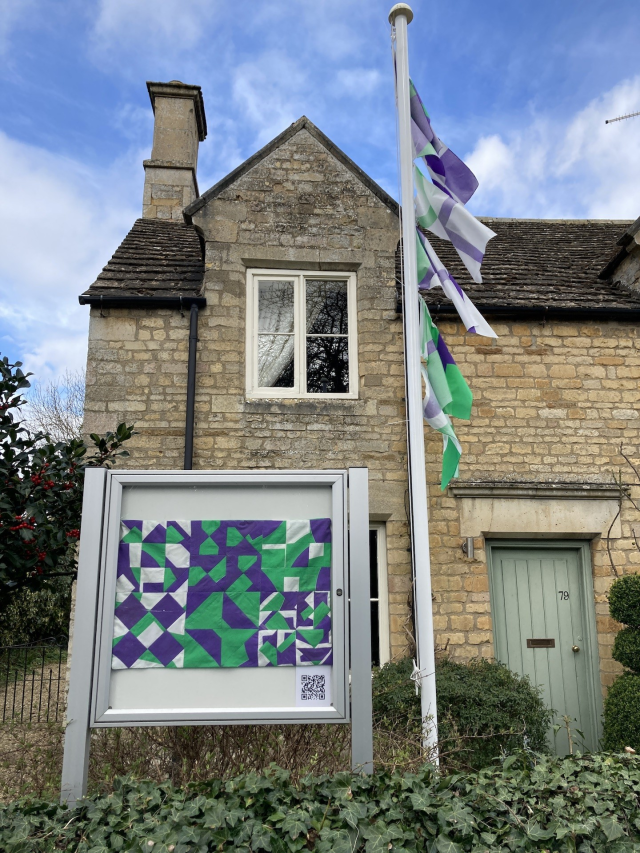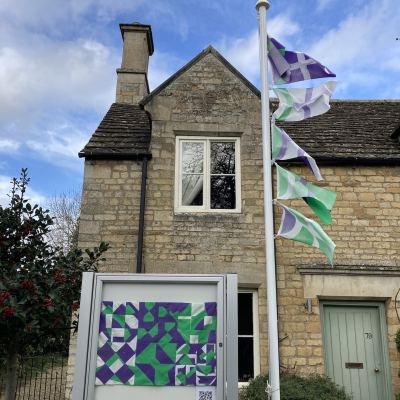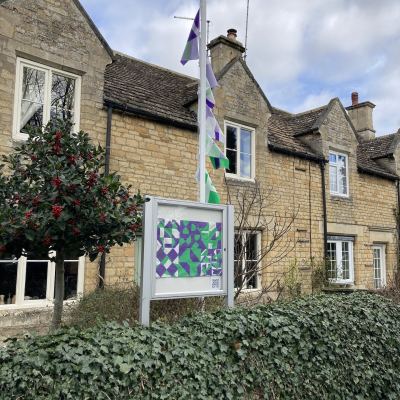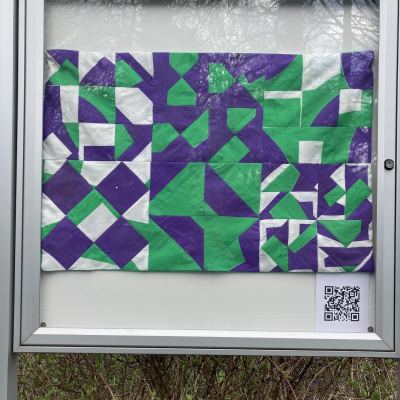Notice Board and Flag Pole Project
Fri 15th Mar 2024
Flags, notice boards, quilts and the power of Symbols.
An essay about my occupation of the notice board and flagpole
Whilst researching the suffrage movement for a commission in 2018 I was struck by the power of repeated colours to convey a message. From this my mind turned to the use of fabric, colour and pattern as propaganda. And thus, to banners as spaces of protest and the use of interlocking pattern blocks in quilts as subversive message bearers during the American Civil war.
From these initial conflations on the meanings of fabric, symbols and colour I came up with a design for a flag with 18 variants and a mini-quilt made from scraps of these flags. I wanted to explore the strong iconography of flags themselves, the Venus symbol representing female gender, and the evocation of a particular colour combination, green white and violet, using fabric, print and sewing.
Humankind are pareidolic animals, perceiving, analysing, interpreting patterns. Signs and symbols surround us. Signs give information or instruction, symbols represent something, something that might needs context to understand. All symbols, colours and shapes come with historical meanings that are ever evolving and changing in meaning and uses. This constant shifting, via adoption, reappropriation, re-assignment and re-framing, makes fixed understanding and interpretation complicated.
Neither the colours of The Women's Suffrage and Political Union nor the female gender symbol have been immune from appropriation to new causes to mean something other than originally intended. Which makes the use of them along with flag form problematic.
Flags are powerful and often contentious things, materially flimsy yet potentially monolithic in meaning. Utilising colour and geometric patterns they evocate emotional responses from patriotism to dissent.
Flags, typically oblong or squares of cloth are used as emblems of a country or institution. The colours and pattern of a flag are carefully designed and considered. Flags are strangely emotive, nuanced from unity, power, control, freedom, segregation, safety, manipulation, fear, danger, marginalisation, to aggressive aggrandising. Most flags are associated with masculine nationhood and patriarchal power systems.
The majority of national flags are geometric with crosses or bands of colour. Some have triangular elements but very few circular elements. Around two-thirds of national flags have symbols; mostly stars, shields, planets. Circles and curves found on flags represent the moon or the sun. Of existing national flags, purple is one of the least used colours, whilst white and green are commonly used.
Flags dictate and demand attention because they are raised up and flying above us. Few objects hold this elevated position and move spontaneously in reaction to natural elements. They are also found folded in a very precise manor or draped over military coffins adding reverence to what is essential just a piece of patterned fabric.
The female gender symbol is derived from the Greek shorthand graphic alchemy symbol for copper and mythological symbol for Venus.
There is a disquieting passivity to it, an empty circle head with cross body beneath that appear vulnerable to big (equally empty) circle headed male with trusting pointy organ. And there is the obvious Christian connotation with the cross.
A circle should be seen as a unifying force. No gaps or sharp edges. Circle is used in reference to a group of people with a shared profession, interests or friendship.
For my flag design I enlarged the female gender symbol so it fell outside the borders of the flag rectangle. My intention was to disrupt its readability, still recognisable yet altered.
The Women's Suffrage and Political Union adopted these three colours to raise visuality, and bring clarity and unity to the cause.
Give - Green = hope, as emblem of Spring that what is demanded will come
Women - White = purity of heart and spirt to the cause of liberty from oppression and inequality
the
Vote - Violet = justice, dignity and loyalty to the cause
The Suffragettes have their detractors and champions but the cause was necessary and hard won.
I used these three colours because they are so identifiable with women’s struggle for freedom and equality. There are 18 variable combinations of the design and three colours. Which seemed serendipitous as in most countries, 18 is the age of majority, when a minor becomes a legal adult and can vote.
18 is too many flags to fly at any one time from a single flagpole. Over the month of my occupancy of the Notice Board and Flag Pole I will be changing the flags flying. The differences are subtle. The same basic geomatic pattern, same three colours, same sized bit of fabric. The flags could be seen as a code, but to what is unknown. There is something monotonous, almost absurd and confusing about series of 18 flags all similar yet slightly different.
The base fabric is white, the green and violet are screen-printed. Consequently, these colours do not penetrate all the way through, the reverse side has only a shadowy suggestion of colour and pattern. This iterates my point that messages and meaning can be unclear.
My mini-quilt on display inside the Notice Board is made up of six different quilt squares/blocks based on designs used in African-American Freedom Quilts. Each block pattern’s meaning conveyed in an abstract geometric design. They have names such as, Nine Basket, Broken Dishes and Crossroad, and each block pattern tells a story, recount traditions, pledges allegiance, or make a statement on beliefs.
Each quilt block is made from extra flags fabric. The cutting and quilting of the original flag pattern in different configuration further scrambling meaning of the female gender symbol and the colours. The six blocks, 22 by 22cms make up a rectangle, and thus another flag.
Contrasting ideas and form: the flags are a domestically made commercial form, the quilt, an everyday functional household object crafted from what is considered an official mass-produced emblem, a flag. Switching and shifting perceptions and further jumbling meanings.
I am using the quilt as metaphor for the repeatedly need to revisit, reappraise, reclaim, rewrite, reconfigure both our past and our future. The act of stitching repairs, or making something from scraps echo’s the psychological and physical sense of repair. To mend or fix something which is damages or faulty. Many feel broken, disadvantaged or fragmented by life. A mend is much needed.
Many gender equalities and freedoms have been won, however not universally. Many are still promised, compromised or reneged upon. All too often Women and those Othered are the first to suffer violence, marginalisation and the indignity of powerlessness.
Each generation has its struggles. The baton passes on, the battles change, the language changes. Thankfully tolerance increases and change happens. To flag means to weaken: flags, flagging or flagged, to hang down; become limp; droop, to decline in strength or vigor, to become weak or tired. It is hard sometimes to keep hope but we must not flag. All women and those Othered need to show resilience and fortitude in the continuing fight for equal representation and freedoms.



